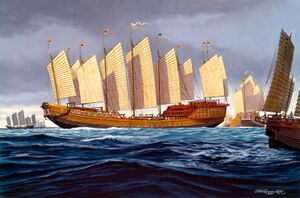São Ricardo International Gateway and Grog Fleet: Difference between pages
mNo edit summary |
m (Text replacement - "Corummese" to "Daxian") |
||
| Line 1: | Line 1: | ||
[[File:GrogFleet.jpg|thumb|Vessels of the Grog Fleet]] | |||
The Grog Fleet was a [[Corumm]]ese naval convoy system operating from the Daxian mainland to the island of [[Zhijun]] on [[Australis]], the purpose of which was the procurement and transport of rum which was made with sugar cane from Zhijun's abundant sugar cane plantations. The Qian Court were great consumers of rum and having no local conditions for the growth of rum's main ingredient, it had to be transported on enormous cargo ships dubbed 'Grog Ships' which could fit hundreds of barrels in their holds. Sailors were given an allowance of watered down rum to consume during the trips, hence the name Grog Fleet, but no actual grog was transported to [[Corumm]]. | |||
Every year, up to five different fleets would make the trip from the port of [[Zong]] to Zhijun. Each fleet was typically composed of around five 'Grog Ships' and each of these had three military escort vessels. During the reign of Emperor [[Tengu the Sot]] the size of the Grog Fleets ballooned to around fifty vessels per fleet formation. This was only barely enough to flood [[Mirzak]] with rum as the Emperor demanded. The cost of furnishing over two hundred vessels across the long distances to Australis for no military or economic gain would in time become a signficant drain on the imperial treasury, leading officials to gradually raise taxes to cover the fiscal hole and eroding the popularity of the Qian dynasty in the decades to come. | |||
[[Category:Corumm]] | |||
| | |||
| | |||
The | |||
[[Category: | |||
Revision as of 01:24, 29 April 2023

The Grog Fleet was a Corummese naval convoy system operating from the Daxian mainland to the island of Zhijun on Australis, the purpose of which was the procurement and transport of rum which was made with sugar cane from Zhijun's abundant sugar cane plantations. The Qian Court were great consumers of rum and having no local conditions for the growth of rum's main ingredient, it had to be transported on enormous cargo ships dubbed 'Grog Ships' which could fit hundreds of barrels in their holds. Sailors were given an allowance of watered down rum to consume during the trips, hence the name Grog Fleet, but no actual grog was transported to Corumm. Every year, up to five different fleets would make the trip from the port of Zong to Zhijun. Each fleet was typically composed of around five 'Grog Ships' and each of these had three military escort vessels. During the reign of Emperor Tengu the Sot the size of the Grog Fleets ballooned to around fifty vessels per fleet formation. This was only barely enough to flood Mirzak with rum as the Emperor demanded. The cost of furnishing over two hundred vessels across the long distances to Australis for no military or economic gain would in time become a signficant drain on the imperial treasury, leading officials to gradually raise taxes to cover the fiscal hole and eroding the popularity of the Qian dynasty in the decades to come.